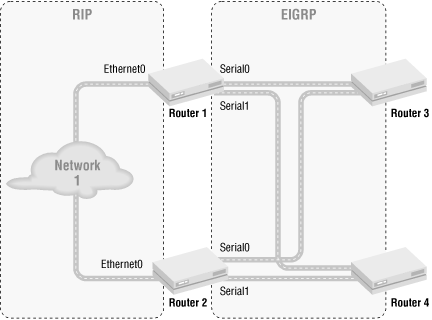Passive Interfaces
The
passive-interface
command tells an interface to listen to
RIP or IGRP routes but not to advertise them. By disabling routing
announcements on an interface, we tell the router to “listen
but don’t talk.” This feature can reduce routing load on
the CPU by reducing the number of interfaces on which a protocol
needs to communicate. For
OSPF and EIGRP, this command completely
disables route processing for that interface. Use this command only
if you know for sure that the routing protocol doesn’t need to
talk to anything on the specified interface.

Figure 8-2. Using passive interfaces
In Figure 8-2, Router 1 and Router 2 can be
optimized with the passive-interface command.
Without getting into the routing protocol specifics, we want to say
“Keep the EIGRP routing on the serial links and keep the RIP
routing on the Ethernet interfaces.” Here’s how:
router eigrp 300 network 192.168.10.0 passive-interface ethernet0 router rip network 192.168.10.0 passive-interface serial0 passive-interface serial1
This configuration tells Router 1 and Router 2 not to send any EIGRP updates over the Ethernet interface and not to send RIP updates over the serial links. It doesn’t solve the problem of getting routing information from our EIGRP process into RIP and vice-versa. We will solve this problem using route redistribution.
EIGRP normally multicasts route information to neighbor ...
Get CISCO IOS in a Nutshell now with the O’Reilly learning platform.
O’Reilly members experience books, live events, courses curated by job role, and more from O’Reilly and nearly 200 top publishers.

